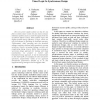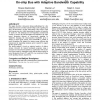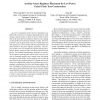1994 search results - page 31 / 399 » The design of a high performance low power microprocessor |
DSD
2008
IEEE
14 years 3 months ago
2008
IEEE
Ultra low power digital systems are key for any future wireless sensor nodes but also inside nomadic embedded systems (such as inside the digital front end of software defined rad...
DAC
2003
ACM
14 years 2 months ago
2003
ACM
This paper describes a low-power design methodology for a bus architecture based on hybrid current/voltage mode signaling for deep sub-micrometer on-chip interconnects that achiev...
VLSID
2000
IEEE
14 years 9 days ago
2000
IEEE
We address the problem of verifying the correctness of pre-silicon models of a microprocessor. We touch on the latest advances in this area by considering two different aspects of...
ICCD
2008
IEEE
14 years 3 months ago
2008
IEEE
— SRAMs typically represent half of the area and more than half of the transistors on a chip today. Variability increases as feature size decreases, and the impact of variability...
ISVLSI
2007
IEEE
14 years 3 months ago
2007
IEEE
As power consumption of the clock tree dominates over 40% of the total power in modern high performance VLSI designs, measures must be taken to keep it under control. One of the m...



